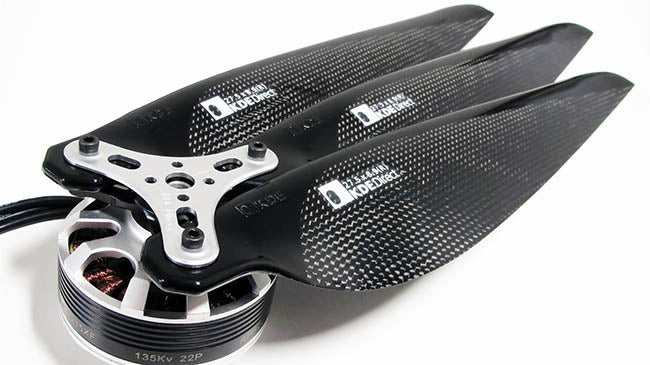Why Drone Propeller Blades Matter | Drone Upgrade Technology

Choosing the right drone propeller blades matters. Why? Flight efficiency. Drone propeller blades have a big influence on power and how smooth your drone flies. One of the biggest factors to consider when considering upgrade technology is how new drone propeller blades improve the flight efficiency of your mutlirotor. When it comes to choosing new drone propeller blades, several factors come into play, including:
- Number of blades
- Blade material
- Power
- RPM
- Pitch
- Air density
- Maximum noise
- Maximum diameter
Drone Propeller Blades
One of the most important factors to consider when upgrading drone propeller blades is the number of blades. How many blades should you use per propeller for optimum flight time and experience?
- Smaller blades under eight inches are most frequently used for racing and acrobatics. Smaller blades are generally paired with smaller motors with high kV ratings.
- Larger blades over eight inches are paired with motors that have low kV ratings. Larger blades and drone propellers can be used to carry heavier payloads, such as video equipment or spraying containers for agriculture.
Next, it’s important to consider blade diameter a pitch. Pitch is defined as the traveling distance per a single revolution of the propeller. Choosing the diameter and pitch often depend on what you will be doing with your drone. Lower pitch often results in more torque and less turbulence for lifting. This means the motors don’t have to work as hard to carry heavy payloads.
What does this mean? Motors that don’t have to work as hard draw less current from the battery, which results in increased flight time. Propellers with higher pitches move more air, but generally create more turbulence and less torque.
When it comes to diameter, a larger diameter equals more air contact. This relates directly to flight efficiency as a small increase or decrease in diameter can change how efficiently your drone flies. Smaller propellers require less effort to speed up or slow down than larger ones. Larger propellers on the other hand, are less responsive, but more stable when hovering. Smaller propellers with a high pitch are better for fast and quick maneuvers, while larger ones with low pitches are better for carrying heavier payloads and aerial video cameras.
When it comes to drone upgrade technology, consider new propeller blades for your multirotor aircraft. Depending on how you plan to use your drone, smaller blades may be better, or if you’re aiming for more heavy lift, consider larger blades. KDE Direct offers drone propeller blades in a variety of sizes, pitches and diameters. Browse our selection to find the perfect drone propeller blades for your specific needs.
Share this post
- Tags: propellers, upgrades




